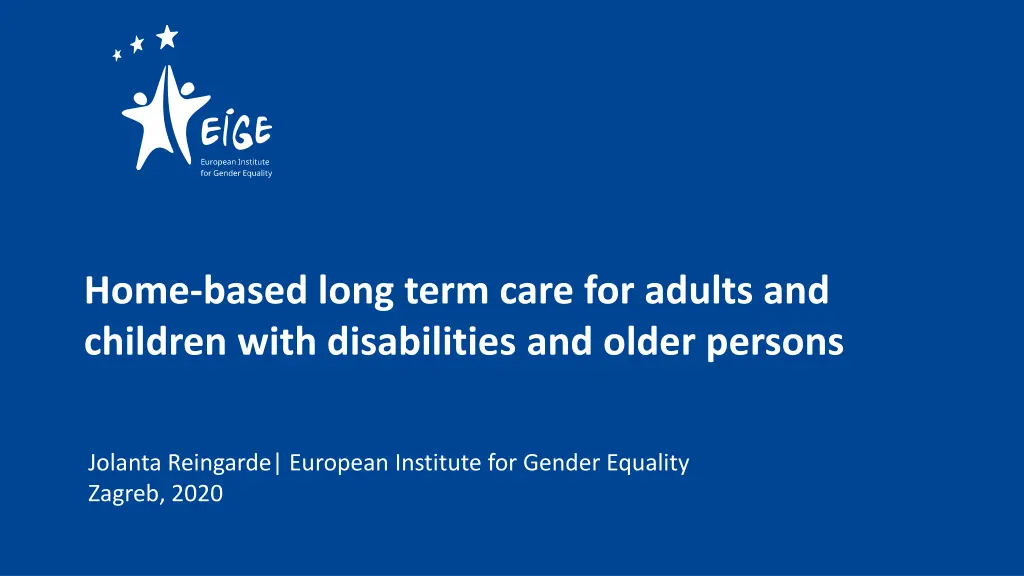
Long-Term Care for Adults with Disabilities and Older Persons
Providing home-based long-term care for adults and children with disabilities and older persons is crucial as the population above 65 years in the EU is expected to rise. The need for LTC services is increasing, especially for women, who often take on caregiving responsibilities. EU objectives aim for universal access, high quality, and long-term sustainability in LTC services. Gender differences in limitations in everyday activities highlight the importance of addressing diverse care needs, including children with disabilities. Despite the prevalence of disabilities, only a quarter of households with people with disabilities receive formal LTC.
Download Presentation

Please find below an Image/Link to download the presentation.
The content on the website is provided AS IS for your information and personal use only. It may not be sold, licensed, or shared on other websites without obtaining consent from the author. If you encounter any issues during the download, it is possible that the publisher has removed the file from their server.
You are allowed to download the files provided on this website for personal or commercial use, subject to the condition that they are used lawfully. All files are the property of their respective owners.
The content on the website is provided AS IS for your information and personal use only. It may not be sold, licensed, or shared on other websites without obtaining consent from the author.
E N D
Presentation Transcript
Home-based long term care for adults and children with disabilities and older persons Jolanta Reingarde| European Institute for Gender Equality Zagreb, 2020
Social context The share of population above 65 years in the EU is expected to increase from 19 % in 2016 to 29 % by 2080 The number of people with disabilities, including children, in need of long-term care (LTC) is on rise Due to longer life expectancy, more women than men are in need of LTC services An absolute majority of professional employees in the care sector are women Women are also more likely to provide informal care to their family members Care responsibilities are keeping 7.7 million women (aged 20-64) compared to 450K men out of the labour market in the EU
EU objectives for long-term care services Universal access: access to services should be affordable for all citizens and not related to the income or wealth situation High quality: focusing on more comprehensive quality assurance involving issues such as patients rights Long-term sustainability: where the likely increase in LTC demand could be mitigated by preventive approaches and technological developments
One in four people in the EU has a long-term disability Source: EU-SILC, Eurostat, 2018
Gender differences in limitations in everyday activities increase with age Women and men aged 65 and over limited in their usual activities, 2018 Source: EU-SILC, Eurostat, 2018
About 5% of EU families with children have a child or children with disabilities Source: EIGE calculations based on EU-SILC, Eurostat, 2017
Only a quarter of households with people with disabilities receive formal LTC Source: EIGE calculations based on EU-SILC ad hoc module, Eurostat, 2016
Every third family in the EU lives without adequate professional home care services Unmet household need for professional home-based care services, 2016 Source: EIGE calculations based on EU-SILC ad hoc module, Eurostat, 2016
Main reason for unmet need inability to afford such services Source: EIGE calculations based on EU-SILC ad hoc module, Eurostat, 2016
Although a demand for LTC is increasing, the sector is facing a major shortage of labour force Social workers providing home-based services per 100 persons with disabilities, 2018 Source: EIGE calculations based on Eurostat data, 2018
During the last ten years the share of women in social work remained unchanged 100% 6,000.0 90% 5,000.0 Numbers of workers in thousands Share of women and men workers 80% 70% 4,000.0 60% 50% 3,000.0 40% 2,000.0 30% 20% 1,000.0 10% 0% 0.0 2008 2009 2010 2011 2012 2013 2014 2015 2016 2017 2018 Women Men Total number Source: LFS, Eurostat, LFS, 2018
In many EU countries employment conditions in the formal care sector are low quality and precarious High intensity of work (determined by high emotional demands, and high workload) Adverse social environment (high risk of abuse, harassment, and under-appreciation) Atypical working time (working at night and/or on weekends, frequent changes to working time arrangements) Low income
Concluding remarks Long-term care needs are on rise and affect women disproportionately Nearly every tenth person enter adulthood with health limitations Shortage of formal long-term care puts economic independence of women at risk Informal carers need support and their contribution to economy needs to be recognized Better remuneration and social protection required for long-term care providers to account for difficult working conditions Ambitious and gender-specific policy goals are needed
Lets talk Connect with us! facebook.com/ eige.europa.eu twitter.com/ eurogender eige.europa.eu youtube.com/ user/eurogender eige.europa.eu/ newsletter eurogender.eige. europa.eu Gedimino pr. 16, LT-01103 Vilnius, Lithuania
